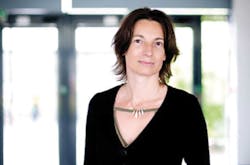3D integration drives nanoelectronics
CEO, CEA-Leti
Fully depleted silicon-on-insulator (FDSOI), Silicon Impulse, and CoolCube are game-changer technologies in the area of 3D integration for CEA-Leti, one of three advanced-research institutes within the CEA Technological Research Division. In an interview at SEMICON West in San Francisco in July, Marie-Noëlle Semeria, Leti CEO, noted that Leti has supported GLOBALFOUNDRIES’ scaling up of its FDSOI 22-nm platform for IoT devices.
And Silicon Impulse, she said, provides a one-stop shop or single-point-of-entry to a silicon ecosystem spanning EDA through the foundry. In addition to Leti, Silicon Impulse partners include CEA-List, STMicroelectronics, Dolphin Integration, CMP, Mentor Graphics, Cortus, and Presto Engineering. “With Silicon Impulse,” Semeria said, “we provide a service in collaboration with our industrial partners to help them evaluate, design, prototype, and launch new products.”
CoolCube is Leti’s 3D sequential integration technology that enables the stacking of active layers of transistors in the third dimension. Semeria explained that CoolCube permits, for example, the stacking of 14-nm FinFETs to achieve the density of 10-nm FinFETs without having to adopt a 10-nm flow. CoolCube, she said, targets mobile and IoT devices where minimal power consumption is key. CoolCube also allows designers to include backside imagers, for example, and it supports co-integration of NEMS in a CMOS fabrication process.
Memory technology was a topic of considerable interest at SEMICON West, and Semeria said Leti is evaluating PCRAM, CBRAM, OXRAM, and MRAM technologies with regard to scalability, power consumption, reliability, and compatibility. As for how the technologies compare, she said, “It’s a very open game.”
Another topic of interest was photonics. “We started working on photonics more than 15 years ago,” Semeria said, “and we have a full library regarding active and passive components.” The organization’s focus is photonics on silicon, and it has implemented III-V lasers on a silicon die. “The technology is very promising,” Semeria said, offering high speed, good thermal performance, and low power consumption.
Topics such as deep-submicron silicon processing, photonics, and memory technology were of particular interest at SEMICON West, and Samaria and her colleagues elaborated on these as well as lighting and high-performance computing in the co-located Leti Day event.
Nevertheless, Semeria said that Leti’s innovation extends to many other topics as well, including biology and life sciences. About 10 years ago, she said, Leti decided to address the medical market with its microelectronics technologies. At the time, Jean Therme of Leti teamed up with Professor Alim-Louis Benabid to form Clinatec, which provided hospital access for clinical demonstrations. Benabid, she said, was one of two scientists winning the Lasker-DeBakey Clinical Medical Research Award in 2014 for his work on deep brain stimulation to reduce tremors and restore motor function in patients with advanced Parkinson’s disease.
And since SEMICON West, Leti and Diabeloop have announced a joint effort to develop an artificial pancreas to improve treatment for type 1 diabetes patients. The effort builds on an earlier three-year research project that included clinical trials.
Semeria explained that across all focus areas, Leti’s mission is to innovate in cooperation with industry, serving as a bridge between basic research and production of micro- and nanotechnologies. The organization has 8,500 m² of cleanroom space for 200-mm and 300-mm wafer processing and a staff of more than 1,800. Leti is based in Grenoble with offices in Silicon Valley and Tokyo, and Semeria said the organization is encouraging more international cooperation. Leti has a portfolio of 2,800 patents, partners with large manufacturers and SMEs, and has launched 54 startups.
Recent startups making use of Leti technology include Exagan, which recently raised €5.7 million to produce GaN-on-silicon devices. Exagan, based in Grenoble with a branch office in Toulouse, was spun off by Leti and Soitec in 2014 and licenses materials and technology from both organizations. Semeria said Leti has invested in GaN technologies in an effort to drive innovation in the power-electronics industry and accelerate development of sustainable-energy technologies in the fields of transportation and energy.
Another startup taking advantage of Leti technology, Semeria said, is Aledia, a developer and manufacturer of next-generation 3D LEDs based on its Gallium-Nitride-on-Silicon platform. Aledia recently announced obtaining up to €28.4 million in financing. The company makes use of 3D nanowire technology, originally developed by Leti, which allows manufacturing of 3D LEDs on 8-inch or larger wafers in existing CMOS foundries.
Semeria became CEO of CEA-Leti in October 2014. During her previous 18 years at CEA, she held a variety of senior-management and strategy-development positions and helped secure numerous patents.
She began her career at Sagem, the high-tech unit of SAFRAN Group. At Sagem, she served as project engineer and was promoted to manufacturing chief engineer, focusing on magnetic memory technologies. Semeria left Sagem after seven years to join the start-up PixTech as chief architect, working on emissive flat-screen technology. She joined Leti in 1996 after three years at PixTech.
Semeria received a doctorate of science in solid-state physics from Joseph Fourier University in Grenoble. In 2011, she was awarded the Legion of Honor, France’s highest professional accolade.

